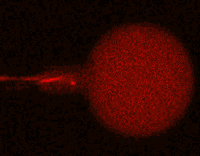This page is historical material reflecting the Feedback Loop Blog as it existed on
September 26, 2013. This page is no longer updated and links to external websites
and some internal pages may not work.
September 26, 2013

Credit: Huey Huang, Rice University.
A new video, starring the toxin in bee venom, might help scientists design new drugs to combat bacterial infections. The video, by Rice University biophysicist Huey Huang, condenses 6.5 minutes into less than a minute to show how the toxin, called melittin, destroys an animal or bacterial cell.
What looks like a red balloon is an artificial cell filled with red dye. Melittin molecules are colored green and float on the cell’s surface like twigs on a pond. As melittin accumulates on the cell’s membrane, the membrane expands to accommodate it. In the video, the membrane stretches into a column on the left.
When melittin levels reach a critical threshold, countless pinhole leaks burst open in the membrane. The cell’s vital fluids—red dye in the video—leak out through these pores. Within minutes, the cell collapses.
Many organisms use such a pore-forming technique to kill attacking bacterial cells. This research reveals molecular-level details of the strategy, bringing pharmaceutical scientists a step closer to harnessing it in the design of new antibiotics.
About the Author
Originally trained in biochemistry, Alisa wrote about the full range of NIGMS-supported research before transferring to the National Institute of Arthritis and Musculoskeletal and Skin Diseases in April 2020. She managed the NIGMS image and video gallery, and helped foster science education at NIH.


